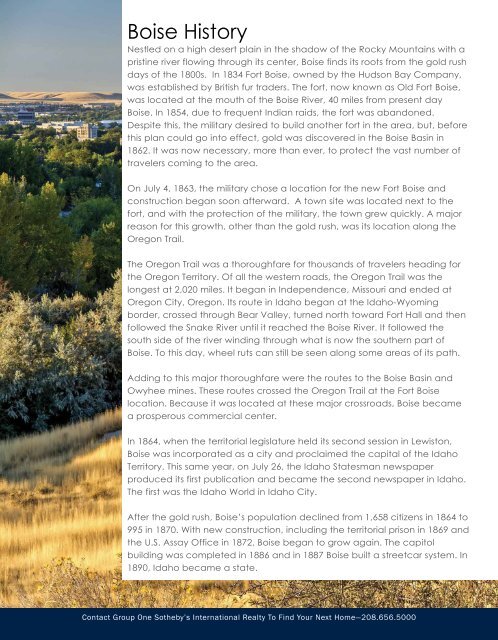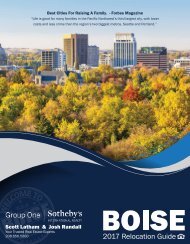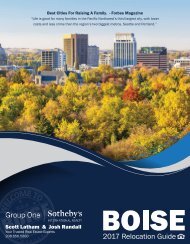You also want an ePaper? Increase the reach of your titles
YUMPU automatically turns print PDFs into web optimized ePapers that Google loves.
<strong>Boise</strong> History<br />
Nestled on a high desert plain in the shadow of the Rocky Mountains with a<br />
pristine river flowing through its center, <strong>Boise</strong> finds its roots from the gold rush<br />
days of the 1800s. In 1834 Fort <strong>Boise</strong>, owned by the Hudson Bay Company,<br />
was established by British fur traders. The fort, now known as Old Fort <strong>Boise</strong>,<br />
was located at the mouth of the <strong>Boise</strong> River, 40 miles from present day<br />
<strong>Boise</strong>. In 1854, due to frequent Indian raids, the fort was abandoned.<br />
Despite this, the military desired to build another fort in the area, but, before<br />
this plan could go into effect, gold was discovered in the <strong>Boise</strong> Basin in<br />
1862. It was now necessary, more than ever, to protect the vast number of<br />
travelers coming to the area.<br />
On July 4, 1863, the military chose a location for the new Fort <strong>Boise</strong> and<br />
construction began soon afterward. A town site was located next to the<br />
fort, and with the protection of the military, the town grew quickly. A major<br />
reason for this growth, other than the gold rush, was its location along the<br />
Oregon Trail.<br />
The Oregon Trail was a thoroughfare for thousands of travelers heading for<br />
the Oregon Territory. Of all the western roads, the Oregon Trail was the<br />
longest at 2,020 miles. It began in Independence, Missouri and ended at<br />
Oregon City, Oregon. Its route in Idaho began at the Idaho-Wyoming<br />
border, crossed through Bear Valley, turned north toward Fort Hall and then<br />
followed the Snake River until it reached the <strong>Boise</strong> River. It followed the<br />
south side of the river winding through what is now the southern part of<br />
<strong>Boise</strong>. To this day, wheel ruts can still be seen along some areas of its path.<br />
Adding to this major thoroughfare were the routes to the <strong>Boise</strong> Basin and<br />
Owyhee mines. These routes crossed the Oregon Trail at the Fort <strong>Boise</strong><br />
location. Because it was located at these major crossroads, <strong>Boise</strong> became<br />
a prosperous commercial center.<br />
In 1864, when the territorial legislature held its second session in Lewiston,<br />
<strong>Boise</strong> was incorporated as a city and proclaimed the capital of the Idaho<br />
Territory. This same year, on July 26, the Idaho Statesman newspaper<br />
produced its first publication and became the second newspaper in Idaho.<br />
The first was the Idaho World in Idaho City.<br />
After the gold rush, <strong>Boise</strong>’s population declined from 1,658 citizens in 1864 to<br />
995 in 1870. With new construction, including the territorial prison in 1869 and<br />
the U.S. Assay Office in 1872, <strong>Boise</strong> began to grow again. The capitol<br />
building was completed in 1886 and in 1887 <strong>Boise</strong> built a streetcar system. In<br />
1890, Idaho became a state.<br />
Contact Group One Sotheby’s International Realty To Find Your Next Home—208.656.5000




